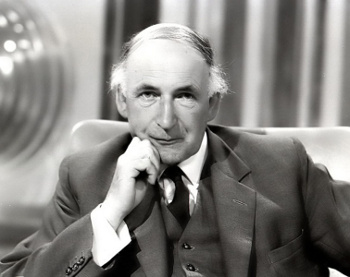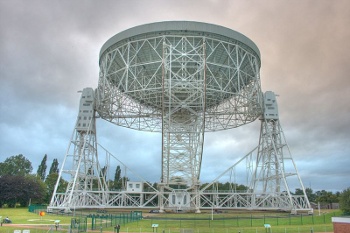Bernard Lovell
August 13, 2012
When I was in
high school, my career aspiration was to be a
radio astronomer. My
science fair project in my
senior year of high school was a
radio telescope. This project was novel for at least two reasons. At that time, few people had any idea that
astronomy meant more than peering at
stars and
planets through an
eyepiece; and, nearly all
electronics were built from
vacuum tubes.
My main information source was the book, "Radio Astronomy for Amateurs," by Frank W. Hyde (W.W. Norton & Company, New York, 1963). Hyde was a
Fellow of the
Royal Astronomical Society living at
St. Osyth, Essex, UK. Once I got past his terminology in which a vacuum tube was a "valve," and his backyard was his "garden," I was able to build a working system at about 80
MHz, just below the
US FM broadcast band.
There is never a strong job market for astronomers, and I found that most people educated as astronomers became
shoe salesmen (perhaps I exaggerate). I thought about an alternative career in
electrical engineering, but I was advised by a working electrical engineer to study
physics, instead. It was a good choice. Now, I dabble in so many things, my specialty isn't easily named.
Bernard Lovell might be the third most famous name in the field of radio astronomy.
Karl Jansky would definitely be first, and
Grote Reber would be second. I wrote about both in previous articles (
LOFAR, Not LOTR, March 2, 2011, and
Don Backer, August 5, 2010. Third place is more contentious. We have the
Nobelists,
Penzias and
Wilson, for example, but my vote is for Lovell. Sir Bernard Lovell died on August 6, 2012 at the age of 98.[1-10]

Sir Bernard Lovell
(August 31, 1913 -
August 6, 2012)
(Jodrell Bank/University of Manchester photograph, via Wikimedia Commons)
Alfred Charles Bernard Lovell was born at
Oldland Common,
Gloucestershire, near
Bristol,
England, on August 31, 1913. He said that seeing a demonstration of
sparks from a
Tesla coil got him interested in
science as a boy.[4] His preoccupations as a boy were
cricket and
church. Lovell played cricket while at
university, but he never played or watched the game on Sundays, the
Sabbath day of rest.[8]
Lovell studied physics at the
University of Bristol under Arthur Mannering Tyndall, who was not the Tyndall of the
Tyndall effect. He remained at Bristol for his
Ph.D. and then accepted a
lectureship in physics in 1936 at the
University of Manchester.[4-5] A year later, he joined
Patrick Blackett, who was later the 1948
Nobel Laureate in Physics, in
cosmic ray research, and remained with Blackett until the outbreak of
World War II.[8]
Lovell worked on the first airborne, ground-scanning
radar system during World War II, a system code-named "
H2S."[4-6] This radar enabled effective nighttime
bombing raids and the detection of
submarines surfacing at night.[8]
During the war, Lovell suggested to Blackett that the unexplained transient radar echoes observed by Britain's coastal defense radar might arise from cosmic rays.[8] It was a possibility, since radar pulses would reflect from
ionized molecules in the
atmosphere. As it turned out, the
ionization was caused by the disintegration of
meteorites, and this led to Lovell's writing the book, "Meteor Astronomy," in 1954.[8]
Effectively
turning swords into plowshares, Lovell re-purposed surplus radar equipment at the end of the war for scientific research.[5-6] His original
observatory location had too much
electrical interference from nearby
electric trains, so he moved his equipment to the William Jauderell (Jodrell) family estate, purchased by Manchester before the war and used by university
botanists.[2,8] The landscape contained a high spot, or "
bank," and thus the Jodrell Bank name.[4]
The simple equipment at Jodrell Bank performed meteor detection, something that my daughter did in 1998 for a
high school science project. Lovell, however, had a greater ambition. In the summer of 1948, he proposed construction of a steerable (
altazimuth) 250-
foot parabolic dish antenna. The antenna would look for extraterrestrial radio sources and track the inevitable
artificial satellites that would soon
orbit the Earth.[4]
Lovell was assisted in design and construction by the
engineer,
Sir Charles Husband.[5] Interesting features of the design were the
trunnions that supported the dish. These were fashioned from parts of the
gun turrets of the decommissioned
battleships Royal Sovereign and
Revenge.[4]
Just as today,
estimating the cost of huge science projects was difficult. The first cost estimate for the telescope was £60,000, climbing to £333,000 in 1952 after construction was underway, the expense being shared by the
Department of Scientific and Industrial Research and the
Nuffield Foundation.[8] The final cost of £670,000 was about double the higher figure, and Lovell became a lightning rod for criticism, and he faced possible imprisonment for overspending public money.[8] All this is recalled in his 1968 book, "Story of Jodrell Bank."[11]

Lovell Telescope, Jodrell Bank
(Photograph taken on August 3, 2007, by Mike Peel, Jodrell Bank Centre for Astrophysics, University of Manchester, via Wikimedia Commons)
All the criticism disappeared just two months after the telescope was completed on August 2, 1957, when
Sputnik 1 became the first artificial satellite. Sputnik, itself, was easy to track, since it contained a
radio beacon, but its
R-7 launch vehicle was not. The Jodrell Bank telescope was the only instrument capable of tracking the R-7 missile, which was the first
intercontinental ballistic missile.[8] Even the
Soviets had use for Jodrell Bank Telescope, since it tracked Sputnik 1 after its
battery power was depleted 22 days after launch.[4]
There were many non-astronomical uses of the Jodrell Bank telescope in the early days of space flight. The Jodrell Bank telescope was the only instrument capable of
transmitting the command over a 22 million
mile distance to separate the
Pioneer 5 deep space probe from its carrier rocket in 1960.[8] In 1966, Jodrell Bank received transmissions from the Soviet
Luna 9 Moon probe, the first craft to make a
soft landing on the Moon. In fact, British newspapers published Luna 9 photographs before they were even released by the
USSR.[10]
Scientifically, Jodrell Bank enabled discovery of many
pulsars, and it allowed radar
rangefinding of the distance to the Moon with great accuracy.[8] Lovell's telescope is still the world's largest fully-steerable telescope, the
Robert C. Byrd Green Bank Telescope in
West Virginia taking first place, and the Max Planck Institute
100 meter telescope at
Bad Münstereifel-Effelsberg, near
Bonn, Germany, taking second place.[4-5]
Jodrell Bank is still relevant after these many years. It will become the headquarters of the
Square Kilometer Array, which will be the world's largest telescope. Unlike Lovell's telescope, the Square Kilometer Array will be an
array of thousands of smaller dishes in
Africa and
Australia whose signals will be combined to become the equivalent of a very large, single dish.[2-3,7]
Lovell was Director of the Jodrell Bank Experimental Station (renamed, later, as the Nuffield Radio Astronomy Laboratories in honor of its private donor; and then, Jodrell Bank Observatory) from 1951 to 1981.[5]. He was elected a
Fellow of the Royal Society in 1955, and he was
knighted in 1961.[1,8] Lovell was president of the
Royal Astronomical Society from 1969 to 1971, and he was awarded the Gold Medal of the Royal Astronomical Society in 1981. He was president of the
British Science Association from 1975-76.[8]
Lovell kept his interest in cricket in his adult years. He was captain of the Chelford Cricket Club and past President of the Lancashire County Cricket Club.[2] As befitted his training, he was called in by the Test and County Cricket Board to review the use of electronic aids for
umpires.[8] He played organ at the Swettenham Church in
Cheshire until his eyesight started to fail in his late eighty.[2,4,8]
Astronomer Royal,
Martin Rees, is quoted by the
BBC as saying,
"Bernard Lovell ranks as one of the great visionary leaders of science. He had the boldness and self-confidence to conceive a giant radio telescope, and the persistence to see it through to completion, despite the risk of bankruptcy. What is even more remarkable is that, more than 50 years later, this instrument (after several upgrades) is still doing 'frontier' science."[1]
The BBC also quoted an unnamed University of Manchester spokesman as saying the Lovell "... continued to come in to work at the Observatory until quite recently when ill health intervened."[1]
Lovell is survived by four of his five children, fourteen grandchildren and fourteen great-grandchildren.[1]
References:
- Astronomer Sir Bernard Lovell dies, BBC News, August 7, 2012.
- Sir Bernard Lovell, Jodrell Bank Web Site, August 7, 2012.
- Sir Bernard Lovell dies at age 98, Astronomy Magazine, August 7, 2012.
- Don R. Hecker, "Sir Bernard Lovell Dies at 98; a Radio Telescope Bears His Name," The New York Times, August 8, 2012.
- Sir Bernard Lovell, Jodrell Bank Observatory founder, dies aged 98, Guardian (UK), August 8, 2012.
- Steve Connor, "Sir Bernard Lovell, pioneer of Jodrell Bank, dies at 98," Independent (UK), August 8, 2012.
- Sir Bernard Lovell, University of Manchester Web Site, August 7, 2012.
- Sir Bernard Lovell, Telegraph (UK) August 7, 2012.
- Rosa Silverman, "Sir Bernard Lovell's death could shed light on 'assassination' Cold War mystery," Telegraph (UK), August 8, 2012.
- Five things you might not know about Sir Bernard Lovell, The Week (UK), August 8, 2012.
- Sir Bernard Lovell, "Story of Jodrell Bank," Oxford University Press, May, 1968, 282 pp. (via Amazon).
Permanent Link to this article
Linked Keywords: High school; radio astronomy; radio astronomer; science fair; senior year; radio telescope; astronomy; star; planet; eyepiece; electronics; vacuum tube; Fellow; Royal Astronomical Society; St. Osyth, Essex, UK; MHz; US FM broadcast band; shoe salesmen; electrical engineering; physics; Bernard Lovell; Karl Jansky; Grote Reber; Don Backer; Nobel Prize in Physics; Nobelist; Arno Allan Penzias; Robert Woodrow Wilson; Wikimedia Commons; Oldland Common; Gloucestershire; Bristol; England; electric spark; Tesla coil; science; cricket; Church of England; university; Sabbath day of rest; University of Bristol; Tyndall effect; Doctor of Philosophy; Ph.D.; lectureship; University of Manchester; Patrick Blackett; Nobel Laureate in Physics; cosmic ray; World War II; radar; H2S radar; strategic bombing; bombing raid; submarine; ion; ionized molecule; atmosphere of Earth; ionization; meteorite; turning swords into plowshares; observatory; electrical interference; electric train; botany; botanist; bank; high school science project; altazimuth mount; foot; parabolic dish antenna; artificial satellites; geocentric orbit; orbit the Earth; engineer; Sir Charles Husband; trunnion; gun turret; battleship; Royal Sovereign; Revenge; cost estimation; Department of Scientific and Industrial Research; Nuffield Foundation; Sputnik 1; radio beacon; R-7 Semyorka; intercontinental ballistic missile; Soviet Union; Soviets; battery; transmitter; mile; Pioneer 5; Luna 9; Moon; soft landing; USSR; pulsar; rangefinding; Robert C. Byrd Green Bank Telescope; West Virginia; 100 meter telescope; Bad Münstereifel-Effelsberg; Bonn, Germany; Square Kilometer Array; phased array; Africa; Australia; Fellow of the Royal Society; Order of the British Empire; knighted; Royal Astronomical Society; British Science Association; umpire; Cheshire; Astronomer Royal; Martin Rees; BBC.